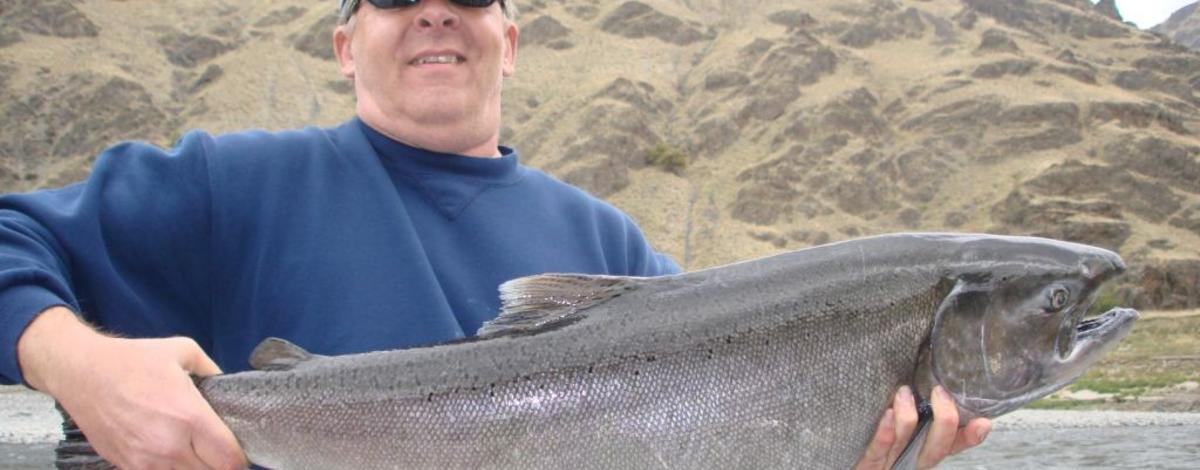Idaho opened its fall Chinook Salmon season on August 18 (commission approves fall chinook season). The word has obviously gotten out that Idaho is providing more opportunities to fish for fall Chinook Salmon. I now regularly receive phone calls and e-mails asking about this fishery, so I thought it would be good to write a blog that addresses the questions I commonly receive.
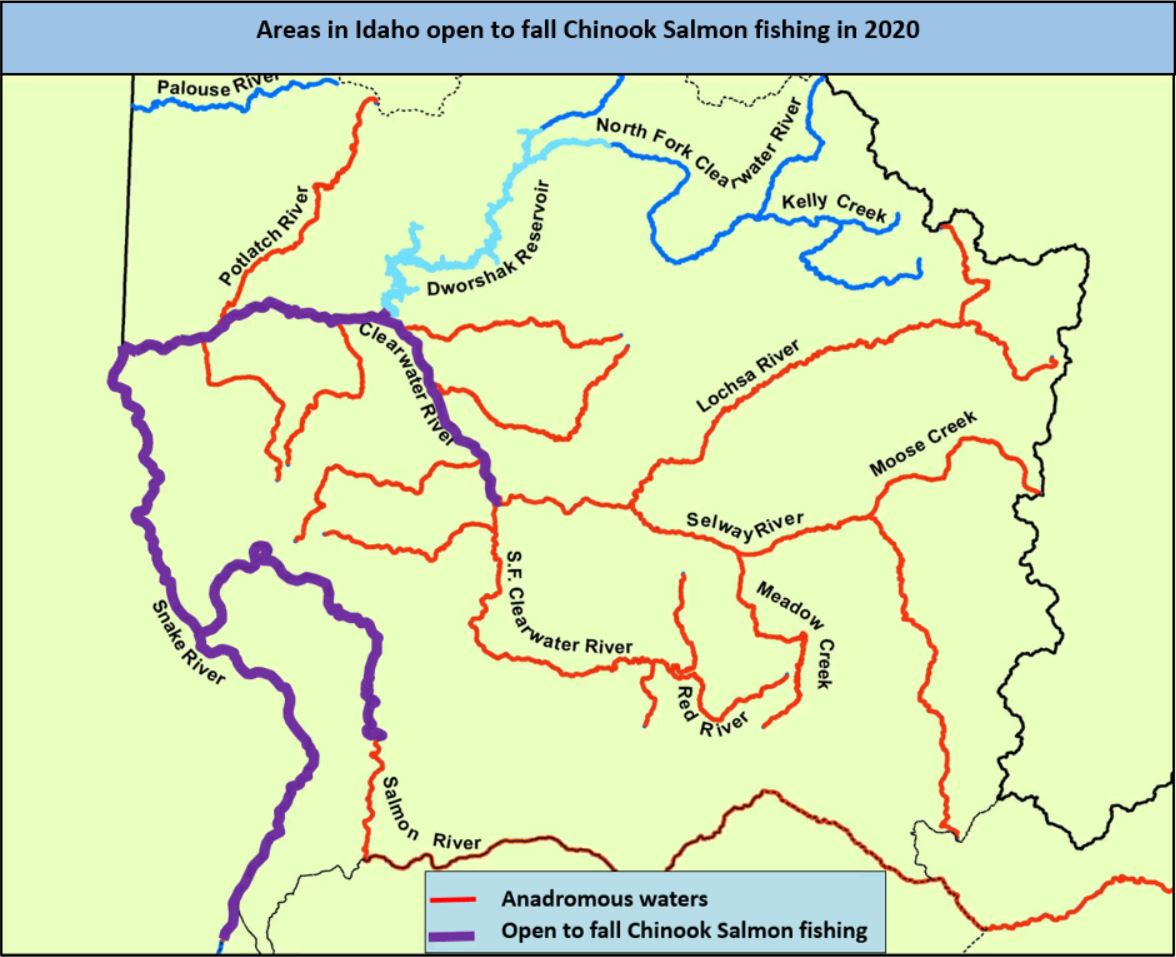
If you review the seasons and rules for fall Chinook Salmon (fall Chinook rules), you will see that the daily limit is three adult fish, but only one may have an adipose fin (be aware this could change in the future). It further states that anglers must cease fishing for all Chinook Salmon (including jacks) once they have retained their daily or possession limit of adult Chinook Salmon. There has been some confusion on whether anglers can continue fishing if they have kept one adult fish with and adipose fin or whether they can keep fishing until they harvest their full (3 adults in this case) daily limit. The answer is, you can continue fishing if you harvest an adipose-intact adult fish up until you harvest your full adult daily limit (or possession limit which is three times the daily limit).
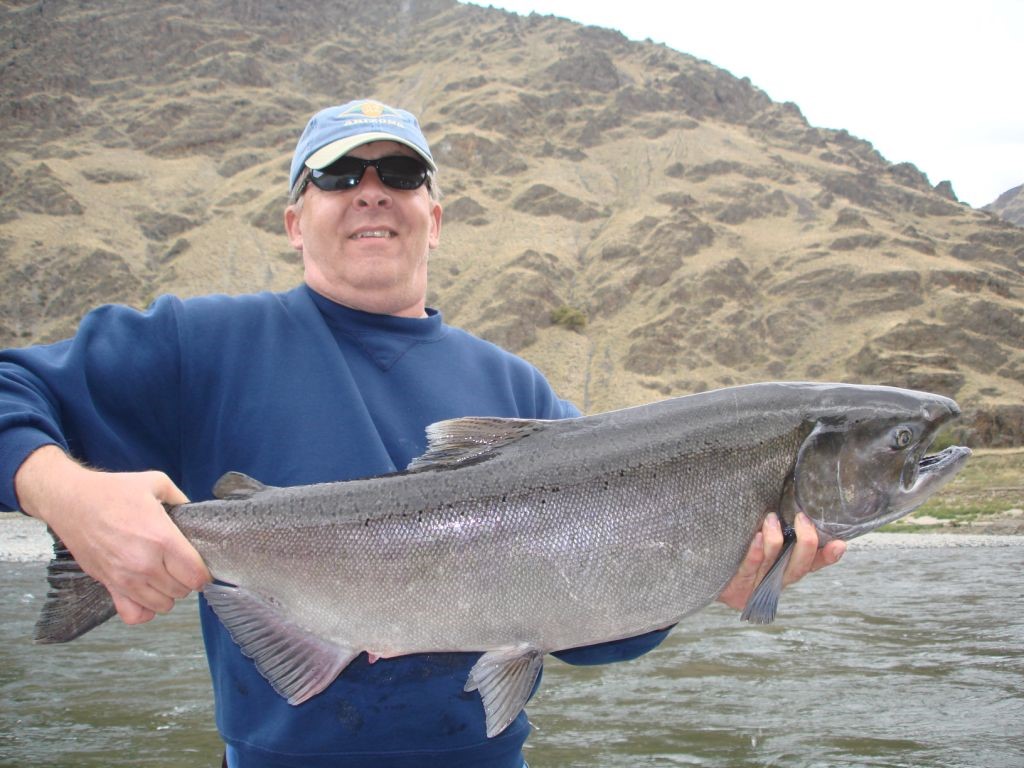
One of the things some anglers don’t understand is why we are allowing harvest of wild fall Chinook Salmon (fish with an adipose fin) when they are listed as threatened under the Endanger Species Act and salmon populations throughout the west seem to be in a dire situation. Fall Chinook Salmon have some aspects of their life cycle that are very different than the spring and summer Chinook Salmon that people in Idaho are familiar with. Some of these differences appear to provide an advantage to fall Chinook Salmon over Idaho’s spring and summer Chinook Salmon populations.
Although fall Chinook Salmon abundance has dropped in recent years, there are still wild populations in the Columbia basin that have flourished even with considerable commercial (in the ocean and Columbia River), sport, and tribal harvest on them. Even the fall Chinook Salmon population returning to Idaho were so abundance just 5-7 years ago that the available habitat could not support them all. Idaho, Washington, Oregon and the Nez Perce Tribe recognized this and developed management plans that were approved by NOAA Fisheries that would allow harvest of a percent of the wild fish dependent on their run size. NOAA Fisheries agreed that harvesting the numbers of wild fish specified in these management plans would not jeopardize the recovery of this fall Chinook Salmon population.
If you are wondering how fall Chinook Salmon differ from Idaho’s spring and summer Chinook Salmon, here are some key differences. The peak timing for when adult fall Chinook Salmon migrate past Lower Granite Dam occurs in mid to late September, and most spawning occurs in lower elevation rivers in October and November. On the other hand, most adult spring and summer Chinook Salmon migrate past Lower Granite Dam in May and June and spawn in higher elevations streams in August and September. After fall Chinook Salmon hatch, the majority of the juveniles immediately start their migration to the ocean reaching it anywhere from June through August. On the other hand, most spring and summer Chinook Salmon spend one year in fresh water before they migrate to the ocean with most reaching the ocean in May.
Finally, once fall Chinook Salmon smolts reach the ocean, they tend to spend their first summer in more local waters and then migrate up towards Alaska. When they are ready to return to fresh water as adults, fall Chinook Salmon tend to migrate back along the Alaskan and Canadian shoreline. After Idaho’s spring and summer Chinook smolts reach the ocean, they tend to make a rapid migration up to the Gulf of Alaska and then move out more into the open ocean before migrating back as adults.

Some anglers have asked whether we have harvest shares for different river reaches where we allow fishing for fall Chinook Salmon. We basically have two harvest shares, one for fish with and adipose fin and one for clipped hatchery fish. If you are wondering, half to two-thirds of the unclipped fish are hatchery fish depending on where you are fishing.
If we approach our harvest share for adult fish with an adipose fin, we can always shut down harvest of those fish and continue to allow harvest of adult fish with a clipped adipose fin. This year, about half the harvest share for unclipped fish will be designated to the Clearwater River and half will be designated to the Snake and Salmon rivers. Because we have not reached our harvest share for clipped fish since starting these fall Chinook Salmon fisheries in 2008, we do not have river specific harvest shares for these fish. Who knows, if interest in these fisheries grow and anglers learn how to catch them in different areas, we may need to develop river specific harvest shares for adult fish with a clipped adipose fin in the future.
One thing that we do very different for fall Chinook Salmon than we do for spring and summer Chinook Salmon is we try to collect all our broodstock at Lower Granite Dam. Lower Granite Dam can divert a portion or all of the fish swimming up the fish ladder into a trap. Once in the trap, we can sort out the fall Chinook Salmon we want to keep for broodstock and allow the others to continue on upstream. The last couple years, we have trapped a higher percent of the fall Chinook Salmon broodstock early in the run. This has allowed us to better meet hatchery broodstock goals and protect wild steelhead which tend to pass over Lower Granite Dam in higher numbers later.
This year the plans are to trap 80% of the fall Chinook migrating up Lower Granite Dam’s fish ladder from August 18 until early September and then drop down to 15%. What this means to anglers is that early in the run fewer fall Chinook Salmon will make it to Idaho and more will make it later. Interestingly, the window where fish are counted at Lower Granite Dam occurs downstream of the fish trap. What this means is between August 18 and early September you can basically subtract 80% from the Lower Granite Dam “Chinook” count to estimate how many actually pass over Lower Granite Dam. For a more complete story on this trapping process, I encourage you to read this article written by the Washington Department of Fish and Wildlife (Fall Chinook trap rates).
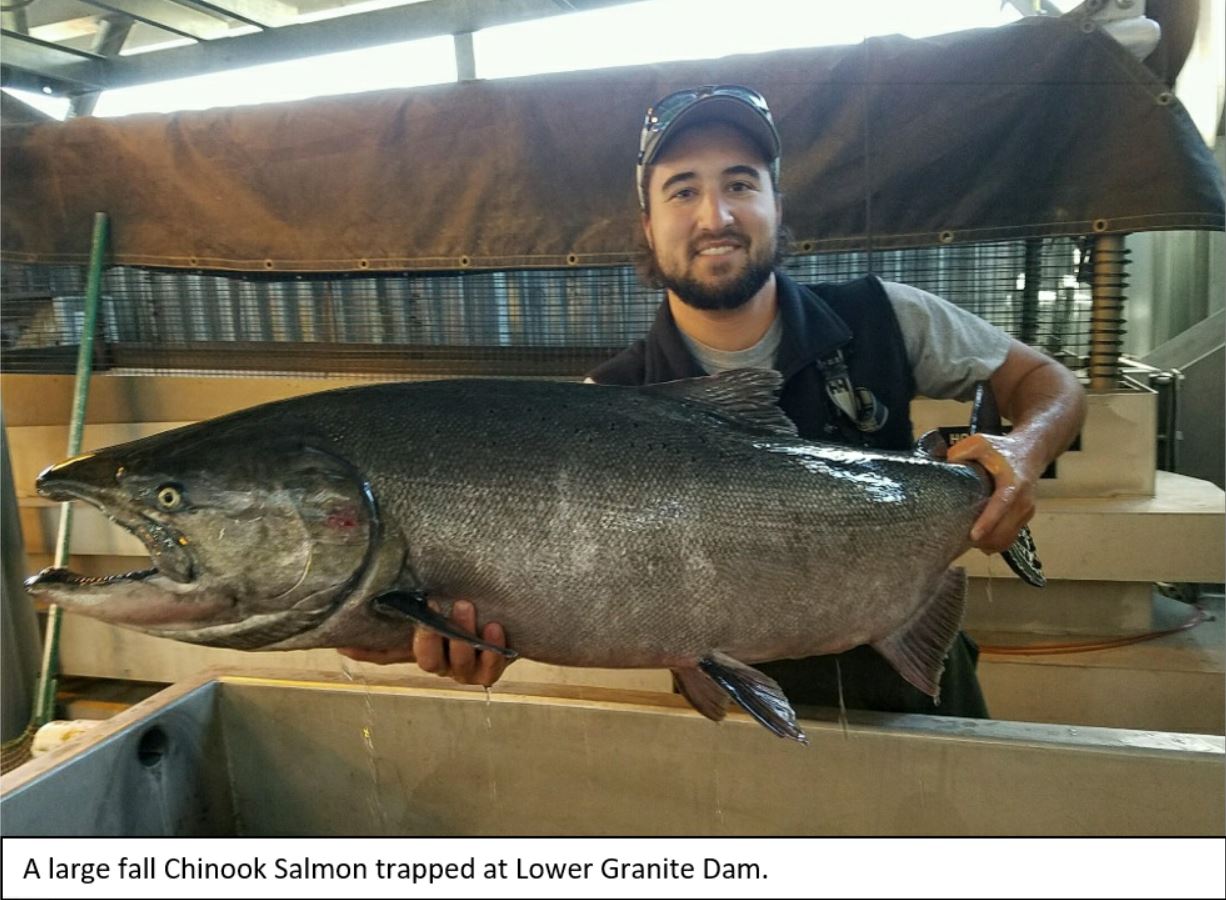
Two years ago (2018), it was decided that fall Chinook Salmon smolts (1,000,000 in total) that were released below Hells Canyon Dam would be released instead in the Salmon River at Hammer Creek boat ramp (near the town of White Bird). This will be the first year adults return to the Salmon River from this smolt release, and it has got a lot of people excited. Because this is the first time adults will be returning to this release location, we don’t know where they will go and where they will try to spawn. Right now we suspect most will not migrate past Twin Bridges boat ramp (12 miles upstream) and is why we only allow fishing for fall Chinook Salmon up to this point. If we learn otherwise, we can extend this fishery further upstream in the future.
It is important for anglers to remember that fall Chinook Salmon spawn in larger rivers often within a month of making it to Idaho. What this means is that the fat and carotenoid pigments stored in their flesh (they come from the food they eat in the ocean) are quickly transferred to their eggs and skin causing their flesh to quickly lose that bright orange/red color we savor so much. As such, if you are fishing in late September or October, don’t expect them to provide the same table fare as a spring Chinook Salmon. Many people prefer to smoke the fall Chinook Salmon they catch later in the season.
The questions I receive the most from anglers new to fall Chinook Salmon fishing are, Where do I go? and How do I catch them? After fall Chinook Salmon make it past Lower Granite Dam, many quickly migrate up the Snake River and stop where the cold water from the Clearwater River enters. Water temperatures in the Clearwater River from August through mid-September are 13-18°F cooler than the Snake River. Because many fall Chinook Salmon stack up in this area, this is where most people fish during this time period. People troll with flashers trailed by scented lures, cut bait, or large plugs. Because the water in the Clearwater River is cold, fall Chinook Salmon destined for this river will often quickly move up into its waters, so fishing up the Clearwater River in September could be good. Many (not all) of the fish destined for the Snake River and Salmon River will hold in the cooler Clearwater River water until the Snake River cools in late September.
Once these fish migrate upstream (whether it is the Clearwater, Snake or Salmon River) they often hold in deeper pools and runs near their spawning areas until they start spawning. As such, targeting deeper water is a good idea. The Clearwater and Salmon rivers provide a lot more shore fishing opportunities although fishing with a boat may be the most effective technique. Once these fish move into these smaller rivers, people catch them with bobbers and jigs, side drifting bait, and back tolling plugs, scented lures, and cut bait. To give you a feel for where the hatchery fish may be heading, I have provided the map below that shows where we release smolts.
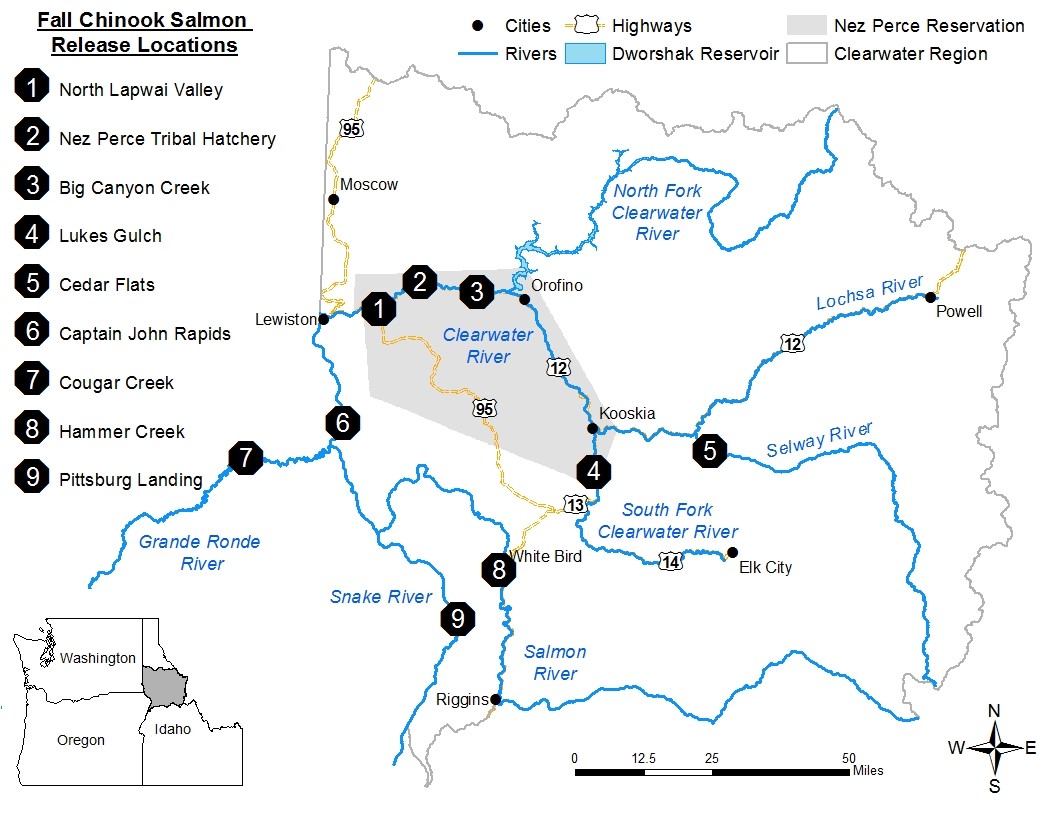
That covers the most common questions I have received this year. As always, if you have more questions, feel free to call or e-mail me.

